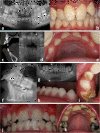A possible cranio-oro-facial phenotype in Cockayne syndrome
- PMID: 23311583
- PMCID: PMC3599377
- DOI: 10.1186/1750-1172-8-9
A possible cranio-oro-facial phenotype in Cockayne syndrome
Abstract
Background: Cockayne Syndrome CS (Type A - CSA; or CS Type I OMIM #216400) (Type B - CSB; or CS Type II OMIM #133540) is a rare autosomal recessive neurological disease caused by defects in DNA repair characterized by progressive cachectic dwarfism, progressive intellectual disability with cerebral leukodystrophy, microcephaly, progressive pigmentary retinopathy, sensorineural deafness photosensitivity and possibly orofacial and dental anomalies.
Methods: We studied the cranio-oro-facial status of a group of 17 CS patients from 15 families participating in the National Hospital Program for Clinical Research (PHRC) 2005 « Clinical and molecular study of Cockayne syndrome ». All patients were examined by two investigators using the Diagnosing Dental Defects Database (D[4]/phenodent) record form.
Results: Various oro-facial and dental anomalies were found: retrognathia; micrognathia; high- arched narrow palate; tooth crowding; hypodontia (missing permanent lateral incisor, second premolars or molars), screwdriver shaped incisors, microdontia, radiculomegaly, and enamel hypoplasia. Eruption was usually normal. Dental caries was associated with enamel defects, a high sugar/carbohydrate soft food diet, poor oral hygiene and dry mouth. Cephalometric analysis revealed mid-face hypoplasia, a small retroposed mandible and hypo-development of the skull.
Conclusion: CS patients may have associated oro-dental features, some of which may be more frequent in CS children - some of them being described for the first time in this paper (agenesis of second permanent molars and radiculomegaly). The high susceptibility to rampant caries is related to a combination of factors as well as enamel developmental defects. Specific attention to these anomalies may contribute to diagnosis and help plan management.
Figures

Similar articles
-
Functional and clinical relevance of novel mutations in a large cohort of patients with Cockayne syndrome.J Med Genet. 2018 May;55(5):329-343. doi: 10.1136/jmedgenet-2017-104877. Epub 2018 Mar 23. J Med Genet. 2018. PMID: 29572252
-
First molecular study in Lebanese patients with Cockayne syndrome and report of a novel mutation in ERCC8 gene.BMC Med Genet. 2018 Sep 10;19(1):161. doi: 10.1186/s12881-018-0677-7. BMC Med Genet. 2018. PMID: 30200888 Free PMC article.
-
Spectrum of ERCC6-Related Cockayne Syndrome (Type B): From Mild to Severe Forms.Genes (Basel). 2024 Apr 18;15(4):508. doi: 10.3390/genes15040508. Genes (Basel). 2024. PMID: 38674442 Free PMC article.
-
[The metabolic and molecular bases of Cockayne syndrome].Rev Invest Clin. 2010 Sep-Oct;62(5):480-90. Rev Invest Clin. 2010. PMID: 21416736 Review. Spanish.
-
Cockayne syndrome group B (CSB) protein: at the crossroads of transcriptional networks.Mech Ageing Dev. 2013 May-Jun;134(5-6):234-42. doi: 10.1016/j.mad.2013.03.004. Epub 2013 Apr 3. Mech Ageing Dev. 2013. PMID: 23562425 Review.
Cited by
-
Genome scan reveals several loci associated with torus palatinus.Orthod Craniofac Res. 2025 Feb;28(1):159-165. doi: 10.1111/ocr.12857. Epub 2024 Sep 18. Orthod Craniofac Res. 2025. PMID: 39291419 Free PMC article.
-
Dental Management of a 14-Year-Old with Cockayne Syndrome under General Anesthesia.Case Rep Dent. 2014;2014:925258. doi: 10.1155/2014/925258. Epub 2014 Dec 10. Case Rep Dent. 2014. PMID: 25574402 Free PMC article.
-
Cephalometric Evaluation of Children with Short Stature of Genetic Etiology: A Review.Children (Basel). 2024 Jun 28;11(7):792. doi: 10.3390/children11070792. Children (Basel). 2024. PMID: 39062241 Free PMC article. Review.
-
Nonsyndromic Generalized Radiculomegaly of Permanent Dentition: A Rare Case Report.Case Rep Dent. 2022 Mar 29;2022:3548370. doi: 10.1155/2022/3548370. eCollection 2022. Case Rep Dent. 2022. PMID: 35392487 Free PMC article.
-
Identification and Characterization of a Novel Recurrent ERCC6 Variant in Patients with a Severe Form of Cockayne Syndrome B.Genes (Basel). 2021 Nov 29;12(12):1922. doi: 10.3390/genes12121922. Genes (Basel). 2021. PMID: 34946871 Free PMC article.
References
-
- Kleijer WJ, Laugel V, Berneburg M, Nardo T, Fawcett H, Gratchev A, Jaspers NG, Sarasin A, Stefanini M, Lehmann AR. Incidence of DNA repair deficiency disorders in western Europe: Xeroderma pigmentosum, Cockayne syndrome and trichothiodystrophy. DNA Repair (Amst) 2008;7:744–750. doi: 10.1016/j.dnarep.2008.01.014. - DOI - PubMed
Publication types
MeSH terms
Substances
LinkOut - more resources
Full Text Sources
Other Literature Sources
Medical

